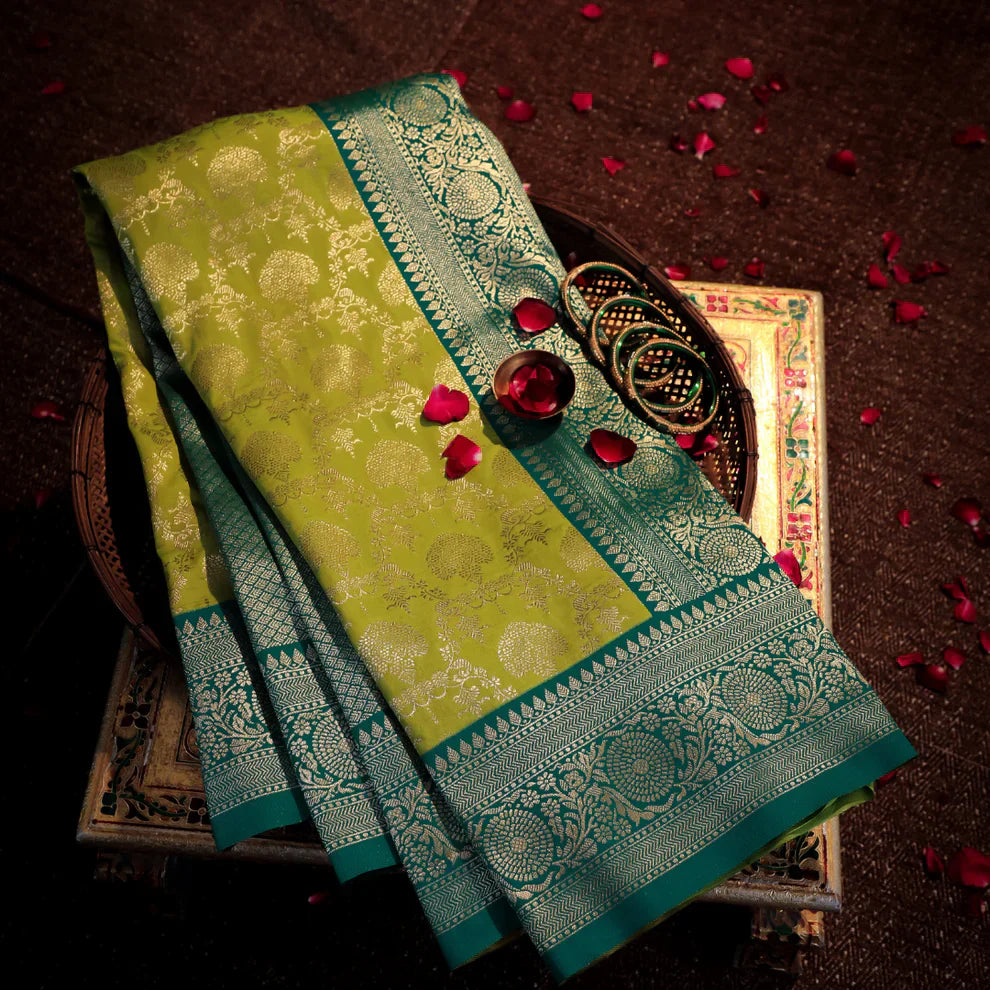
The Story of Kanjivaram Silk A Heritage Woven in Gold
Megha MuleIndia’s love affair with silk is as old as its civilizations. Among all silk varieties woven across the subcontinent, Kanjivaram silk stands tall — a luxurious drape synonymous with elegance, purity, and cultural pride. With roots tracing back centuries, this traditional weave isn’t just fabric; it’s a living story, woven with care, precision, and heritage.
The Roots of Kanjivaram Silk
Kanjivaram, a small temple town in Tamil Nadu, is often called the “Silk City of India.” Renowned for its majestic temples and vibrant religious culture, this sacred town has also been the birthplace of one of India’s finest textile traditions.
The tradition of silk weaving in Kanjivaram is believed to have begun over 400 years ago, during the reign of the Pallava dynasty. Skilled weavers from Andhra Pradesh’s weaving communities — the Devangas and Saligars — migrated to Kanjivaram. They brought with them a deep knowledge of silk weaving and began producing sarees inspired by South Indian art, architecture, and mythology.
What Makes Kanjivaram Silk Unique?
Kanjivaram silk sarees are not just beautiful; they are distinct in their weaving technique, richness, and durability.
Here’s what sets them apart:
● Pure Mulberry Silk
The base material of a Kanjivaram saree is pure mulberry silk. This silk is soft yet strong and has a natural sheen. It’s primarily sourced from Karnataka, ensuring high quality and longevity.
● Real Zari Borders
Kanjivaram sarees are often adorned with zari — a fine gold or silver thread. Traditionally, zari used in these sarees was made from pure silver dipped in gold. The intricate gold borders and motifs elevate the saree's elegance.
● Contrasting Borders and Pallus
Unlike many sarees where the body and border are woven together, Kanjivaram sarees have borders and pallus woven separately, and then joined to the body. The joint is known as the korvai technique and is said to be so strong that even if the saree wears out, the joint remains intact.
● Inspired Motifs
Designs on Kanjivaram sarees are often inspired by temple architecture, nature, epics, and folklore. You’ll find motifs like peacocks, mangoes, elephants, checks, stripes, lotuses, and depictions of mythological tales.
The Weaving Process: A Labor of Love
Creating a single Kanjivaram silk saree is an art that takes 7 to 20 days, depending on the design. The process is entirely manual, involving immense patience and skill.
Step-by-Step Weaving Journey:
-
Silk Thread Procurement:
The pure mulberry silk yarn is sourced from Karnataka and prepared for weaving.
-
Dyeing:
Silk threads are dyed in vibrant colors using traditional and safe dyeing methods.
-
Zari Work:
Pure silver wires are dipped in gold and rolled into thin threads to create zari borders and motifs.
-
Handloom Weaving:
Using traditional looms, the saree body, border, and pallu are woven separately and then interlocked. This step requires sharp mathematical precision.
-
Finishing Touches:
The final saree is washed, ironed, and folded — ready to become someone’s treasured possession.
Symbol of Culture and Tradition
In South Indian culture, Kanjivaram silk sarees are an emotional heirloom. They are not just worn — they are cherished.
-
Weddings:
A Kanjivaram saree is often the bride’s first choice. In Tamil Brahmin weddings, the bride wears a bright red or maroon Kanjivaram saree, often with gold zari, to symbolize prosperity and purity.
-
Festivals and Religious Ceremonies:
From Diwali to Pongal and temple visits, wearing a Kanjivaram saree signifies devotion and grace.
Inheritance:
Many women pass down their Kanjivaram sarees to daughters and granddaughters — a tradition steeped in emotional value.
How to Identify a Genuine Kanjivaram Silk Saree?
Due to its popularity, the market has many imitations. Here’s how you can spot the real deal:
-
Silk Mark:
Always look for the “Silk Mark” certification tag — a government-authorized guarantee for pure silk.
-
Zari Check:
Original zari is made from silver and gold plating. Fake zari will appear dull and may turn black over time.
-
Texture and Weight:
Kanjivaram silk has a rich texture and is heavier than artificial silk sarees.
-
Joint in Border and Body:
If you notice a strong weave where the border is attached to the saree body, it’s likely authentic Kanjivaram.
Empowering the Weaver Community
The Kanjivaram silk industry supports thousands of families. Handloom weaving is not just a livelihood; it’s a way of life. While the rise of power looms has affected traditional handloom weavers, many government and private organizations are working to revive and support the community through:
-
Fair wages
-
Training and education
-
Global exhibitions
-
Online platforms for direct sales
